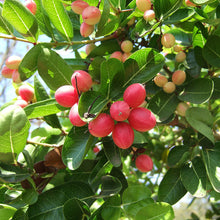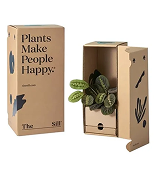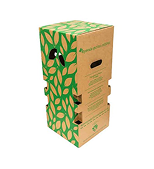- Home
- Outdoor Plants
- Karonda/Carissa Carandas - Fruit...
Karonda/Carissa Carandas - Fruit Plants & Tree





Karonda/Carissa Carandas - Fruit Plants & Tree




Damaged or lifeless? We’ll replace it for free. Learn more

Double layered custom boxes to protect plants during shipping.

Air vents for proper air-flow

To preserve plant freshness during transit

Details steps of how to grow and maintain your plant
Karonda is botanically known as Carissa carandas from the family Apocynaceae. Karonda is a medium-sized, thorny shrub. It has a greenish white bark on young shoots and greyish brown on mature stems. The spines are straight and 1-3 cm long. Its leaves are 2-3 cm long and shiny green above and a dull green shade below. Old leaves keep shedding throughout the year.
It is rich in iron, vitamin C, vitamins A, calcium, and phosphorus. It is antiscorbutic and very useful for the cure of anemia. Karonda fruits are used in many ayurvedic formulations and are useful to their nutritional values. The extract of the root is used for Chest pain. The extract of leaves is used for fever(there is no scientific belief for this)
Growing Tips
- It can be grown in a pot or directly in the soil in full sunlight areas.
- It can be grown successfully in tropical and subtropical climate. plant growth is affected in high rainfall and waterlogged areas.
- Karonda is grown successfully on a wide range of soil types, viz. sandy loams, laterite, alluvial sand, and calcareous soil even it is found growing well in in stony, rocky and less fertile soils.
- But the better growth and higher yield is obtained in alluvial sandy loam soils with good drainage. It's growth are affected by high rainfall and water logged areas.
TEMPERATURE - Between 20-35 Degree Celsius.
MAXIMUM HEIGHT - It can reach up to 5 meters (if planted in the ground)
BLOOMING YEAR - Flowering occurs from February to June.
FRUITING TIME - It starts fruiting after 2-3 yrs after planting.
Fertilizer - Organic Fertilizer once in 3 months.
INSIDE THE BOX
| S.No. | PRODUCT NAME | DIMENSION |
| 1. | Karonda Plant | 1 Feet Height |
| 2. | Growing Pot (Black color) | 6 Inch |
*above specifications are for indicative purposes only, actual dimensions may slightly vary.
INITIAL CARE FOR 10-15 DAYS JUST AFTER RECEIVING YOUR PLANT
- Remove the Packaging Materials carefully.
- Press the soil in the pot & add additional soil(garden mix) if necessary.
- Maintain moisture in the pot, Do not overwater it may kill your plant, so make sure that the soil should be dry between watering.
- Make sure that plants get enough morning direct bright light(2-3hrs) for 10-15 days & do not go for immediate transplanting (minimum 1 month)
- After 1 month you can transplant it into a slightly bigger pot than the present pot or directly in the ground.
- Just prune if any branch of the plant is get damaged in transits. New leaves will come definitely.
Selected plant of 8-10 inches
Planted into a 5-inch pot
With healthy, moisture-retaining soil
A care instruction sheet for maintenance guide

Get in touch for best pricing on bulk orders and landscaping projects.
 WhatsApp us
WhatsApp us

Call on 9177805454 (Mon-Sat, 9 AM-6 PM) or WhatsApp us – we’re here to help.
About Exotic Flora
At Exotic Flora, we’re passionate about bridging the gap in bringing plants to everyone. With over 500+ varieties across 7 plant categories, from exotic finds to everyday greens, we bring the entire range to you.
Our plants, sourced from all parts of India are nurtured at Kadiyam, in our 25 acres in-house nursery by a team of expert horticulturists. Once they are ready we ship all our plant varieties across India.
Our services go beyond safe delivery of plants. A dedicated support team is there to help you with any maintenance queries you may have.
At Exotic Flora we always believe in going that extra mile, because everyone should have the plants they love.
Every, fruit plants vary in their fruiting time, depends on location, climate & age of the plants. Generally, Grafted fruit plants starts fruiting within 2 years of planting, where as non-grafted plants take more than 2 years. You can check the fruiting time of each plant in the plant description.
No, Majority of fruit plants are not delivered with fruits. But some grafted fruit plants can be delivered with fruits and flowers mostly Citrus, Guava, Star fruit, Fig, Ber etc. But it is recommended to remove the flowers during early days, so that plants can get more branches and physical strength.
Grafting is a technique where two plants part are combined together so that they can grow together. Most commonly seen in Mango. Air Layering is also a vegetative propagation technique where a plant is produced while it is still attached to its parent's plants. Commonly seen in Guava. Stem cutting is a vegetative propagation technique, where soft, semi-hard, or hardwood stem is cut with 2-3 nodes and used for the multiplication of plants. Commonly seen in flowering & ornamental plants.
Yes, the grafted fruit trees produce fruit earlier, than the non-grafted fruit plants.
These are some of the rare and new fruit plants and it's varities, which are not avialable everywhere in our country.
Remove the plant from its pot. Make sure to not disturb the root ball. Place the plant in a prepared pit(1x1ft) or slightly bigger pot than the current pot. Firm the soil around the plant with your hands. Water well till it drains out from the drainage hole.
In order to maintain the good shape of the plants, proper care should be taken from the beginning like the pruning of unwanted and diseased parts of plants, stalking to young plants, regular maintenance of plants.
In General, a grafted/air layered/hybrid fruit takes 2 years for fruiting, whereas seeded grown plants take 4-5 years of time for fruiting. But it may vary depending on the plant types.
In general if your soil weell drained, fertile and organic in nature, it will produce good quality fruit. Sandy-loamy is the most preferable soil used for fruit plants.
Size and taste of each fruit plants varies depending on the varieties. You can find more details about each fruit plants in terms of size and taste in the description of individual plants.
Initial first 2 years are very important to feed the plants with organic manure and fertilizers regularly. It is recommended to add organic manure or compost to each plant in every 3 months of time intervals. Do not go for Chemical fertilizers it will weaken the plants in future.
Plastic pots with drainage holes preferably work best as they are lighter to move around. Any other container which is light in weight with a drainage hole can also work to grow fruit plants.
Thank you team Exotic Flora for fulfilling my dream of having my favourite fruit tree all for myself. As a kid and in fact even now my favourite fruit, the Karwanda berries are rare and hard to find in the city. But in due time, thanks to you I will now be able to grow them and relish them every summer...fresh from my own garden...
Thank you!!
यह पौधा बहुत ही अच्छा था